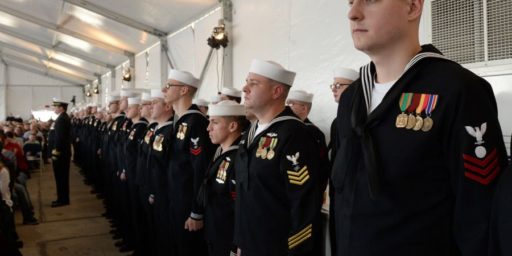Army Looks For Airmen And Sailors
NYT – Other Services Eyed by Army for Recruiting
The Army is looking for a few good sailors and airmen. Actually, more than just a few. In what some military experts see as another sign of how the Army’s commitments in Iraq and Afghanistan have strained it, the service for the first time will soon begin aggressively recruiting thousands of sailors and airmen who are otherwise scheduled to leave the Navy and Air Force because of cutbacks. Under a new program called Operation Blue to Green, the Army plans to offer bonuses of up to $10,000, in some cases, and four weeks of extra training to airmen and sailors willing to trade in their dress-blue uniforms for Army green fatigues. The Army is especially interested in men and women who have jobs that are readily transferable to Army positions, like mechanics and logisticians.
Many details must still be worked out and final Pentagon approval is still pending, but Army officials say the new program is a marriage of convenience. The Army is temporarily increasing its ranks by 30,000 soldiers by 2006, and will need to recruit at least 77,000 soldiers this year and 80,000 next year to meet that goal. Meantime, the Navy and Air Force are shrinking. The Air Force intends to cut its forces by 22,500 next year, the Navy by 7,900. “This is an opportunity for all the services to work together,” said an Army officer who is working on the new program. “It’s a way to make sure those men and women who want to serve can continue to serve.”
If all goes according to plan, the program will begin around Oct. 1, Army officials said Thursday. While the program has not been formally announced, the Army two weeks ago posted details about the program on its Web Site, www.goarmy.com. So far, officials said, more than 100 people have already expressed interest in switching services. “Operation Blue to Green will allow you to continue to serve your country, to maintain the benefits of military service, and to expand your horizons by gaining new training and trying new things,” said a description of the program on the Web site.
Army officials said transferring enlisted personnel from one service to another would require a change in Pentagon policy, but could also save as much as $10,000 per service member in training and recruiting costs. On Capitol Hill, senior House and Senate leaders, including Senator John W. Warner, the Virginia Republican who heads the Senate Armed Services Committee, endorse the plan. Representative John M. McHugh, a New York Republican who heads the House Armed Services total force subcommittee, said the concept kept valuable service members in the armed forces, although in a different branch.
“Is it wise to just let those folks go with those kind of skills just because they are caught up in downsizing?” Mr. McHugh said in a telephone interview. “This is common sense.”But some military personnel experts said the move was yet another last resort by the Army to fill its ranks. In recent weeks, the Army has said it will call up 5,600 members of the Individual Ready Reserve, former soldiers who have left the Army and not joined the Reserves. The Pentagon has extended the tours of thousands of soldiers bound for Iraq or Afghanistan who had been scheduled to retire or leave the service. And, for the first time, the military deploying combat troops to Iraq from South Korea. “It’s further evidence of the strain the Army is undergoing,” said Richard I. Stark Jr., a retired Army colonel who is a senior fellow at the Center for Strategic and International Studies. “There is a short-term manpower crunch in the Department of Defense, especially in the Army.” Army officials insist that recruiting and retention for active-duty, Reserve and National Guard forces remain strong and, in some cases, have exceeded goals for the year to date.
***
The “blue to green” program, was first reported in the current issue of U.S. News & World Report, was conceived by mid-level Army personnel officials in February. But the idea was so novel, it took several weeks for it to catch on with senior Pentagon officials, Army officers said on Thursday. “We’re in uncharted waters here,” said one officer.
Under the plan, airmen and sailors, typically with fewer than eight years’ experience who are leaving the military with honorable discharges, would be eligible for the program. Most applicants would be enlisted personnel, but junior officers could also apply. Applicants who switched services would remain at the same rank. Air Force and Navy personnel would be required to take a modified, four-week Army basic-training course, officials said.
Additional training would depend on how similar the new Army job was to the Navy or Air Force job, officials said. Service members transferring to the Army would be required to serve a minimum of three years, according to an internal Air Force personnel notice that advertised the new program.
Small numbers of officers now switch services – doctors are common, for instance – but Army officials said they were still working out recruiting projections for the new program.
Navy officials said about 3,200 sailors and officers who are leaving or have left the service for various reasons in the past year might be eligible for the program. “The Navy believes this offers a unique opportunity for a departing sailor or officer to continue to serve for his country,” said Cmdr. John Kirby, a Navy spokesman.
While my initial reaction to the lead paragraph was sarcastic and mildly profane, this actually makes a world of sense. Indeed, it’s very unlike the Army to put aside institutional rivalry and a natural disdain for the inferior services to do this. But as more soldiers do technical jobs, there’s no reason that former squids and zoomies can’t do them. And, surely, four weeks will be long enough to teach them which end of an M-16 is which.




…inferior services…
Snort!